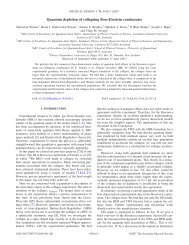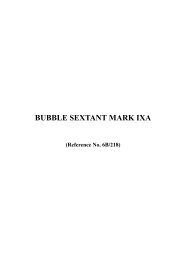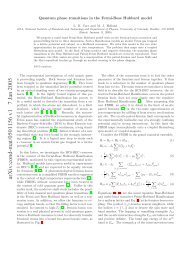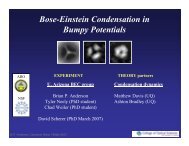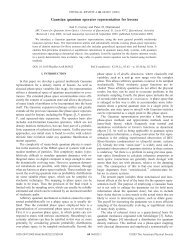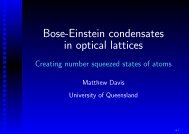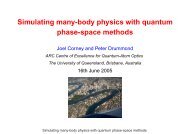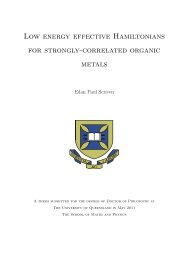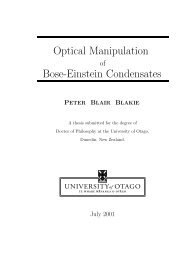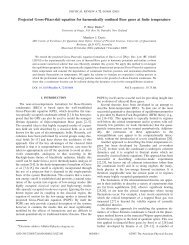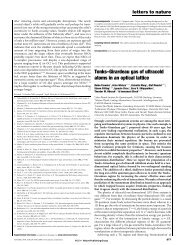Open Quantum Dynamics of Mesoscopic Bose-Einstein ... - Physics
Open Quantum Dynamics of Mesoscopic Bose-Einstein ... - Physics
Open Quantum Dynamics of Mesoscopic Bose-Einstein ... - Physics
Create successful ePaper yourself
Turn your PDF publications into a flip-book with our unique Google optimized e-Paper software.
3. Homodyne measurements on a <strong>Bose</strong>-<strong>Einstein</strong> condensateFor N = 100 atoms, χ>10 −3 s −1 should give detectable phase shifts (0.1 radians), andshould be experimentally feasible. For example, in terms <strong>of</strong> the incident intensity I on theatom, the atomic linewidth γ a , the total photon number N P , and the saturation intensityI s , the dipole coupling constant is[52]√Ig d = γ a . (3.5)N P I sFor a cavity <strong>of</strong> length l irradiated with light <strong>of</strong> frequency ω, the photon number is N P =Ilw 2 /(ωc). So the atom-light coupling strength becomesµ = ωcγ2 a4lw 2 . (3.6)∆I sIn the simulations given later in this chapter, the maximum measurement strength isχ ≈ 10 3 s −1 , which can be achieved by using the parameter values listed in Table 3.1, basedon the 5S 1 −→ 5P 3 transition in Rubidium[52]. The narrow width <strong>of</strong> the intracavity field22means that the power required to achieve the necessary coupling strengths is extremelysmall.The cavity is driven by a strong coherent field <strong>of</strong> strength ɛ and strongly damped atthe rate γ, and thus the cavity field is close to the coherent state α 0 =2iɛ/γ. Themasterequation for the whole system (cavity field plus condensate) is]]2 ˙ˆρ tot = −iΩ[Ĵz , ˆρ tot − i2κ[Ĵ x , ˆρ tot− iɛ]+ iχ[â † âĴx, ˆρ tot[â † +â, ˆρ tot]+ γ 2− i(δ − Nχ2 ) [â † â, ˆρ tot](2âˆρ tot â † − â † âˆρ tot − ˆρ tot â † â), (3.7)where the initial cavity detuning δ = Nχ/2ischosentoremovetheN-dependent lineardispersion.The optical field may now be adiabatically eliminated from the master equation [126,181], under the assumption that the driving and damping terms dominate the couplingterm. To do this, we first transform the master equation to a displacement picture usingthe displacement operator D(α 0 )=exp(αâ † − α ∗ â) which creates a coherent state ∣ 〉α0from the vacuum state:˙˜ρ = D † (α 0 ) ˙ˆρ tot D(α 0 )=[(S ˜ρ + iχ â † â + α ∗ 0â + α 0â † + |α 0 | 2) ]Ĵ x , ˜ρ + γ ()2â˜ρâ † − â † â˜ρ − ˜ρâ † â , (3.8)2where S incorporates the condensate dynamics. For large damping γ, then〈 〉∣ S ∣∣∣∣ ∣ γ ∣ ∼ χ|α 0 | 〈 〉Ĵ x γ ∣ = ɛ 0 ≪ 1, (3.9)63



